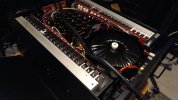So it would seem the supposed greatest country in America, and supposedly the world, has such a crappy electrical grid then, so to speak.
For the most part, per friends who are in the power field (I am not, more high-speed/RF stuff), the grid itself is pretty "clean". I don't recall the requirements any more but we have engineers on ASR working in the power field who can probably say the specs without trouble. In a home things like light dimmers, fan motors, freezer units, laser printers, and other appliances can generate noise spikes. Our treadmill kicks a fair amount of noise back into the wall socket when it is not serving its primary purpose as a clothes hanger.
Yes i would tend to agree, that it is quite easy for capacitors and switching transistors to fail. The problem however has always been the manufacturers refusal to use parts that would avoid this very thing. While improvements happen over time, you still have a new up an comer like hypex , making modules with chinese caps, then finally switching to higher quality name brand caps, but even then still using standard 2000hr at 105c rated capacitors. Like how many times does the cycle have to repeat itself , until SMPS manufacturers, get the MEMO. ??? To these guys we are talking about dimes and nickles per capacitor savings over using a part that would significantly raise the life and reliabiliy of SMPS.
Cost/profit vs. MTBF (mean time before failure) is always a trade. A few pennies adds up over millions of units, and I'd guess most any engineer has had to deal with the "bean counters" during product development. Sometimes we win, sometimes we lose... Many of us may not like it, but many customers prefer to pay less even if long-term reliability is sacrificed. There is a wider trend pushing ease of repair that might help, we'll see. Perhaps as competition increases in the class D arena this will receive more attention. I also wonder if we'll see a "premium" product line from some manufacturers at some point with better components (albeit not likely significantly better performance). Some of the companies provide manufacturer-specific designs (for a price) so that is another avenue for improved products. I'd guess a company like Bryston would not want 1000 hour, 85 degC caps in a SMPS they covered with their 20-year warranty. But so many consumer products have such short lifetime anyway, especially HT products that change standards every other year, that it's just not worth it. A number of us have and love our older gear, but how many consumers in the world at large will still have today's amp or whatever ten years from now?
Transformer HUM from DC,? I Have yet to experience that one. Most people no matter what amplifier they have seem to run into hum simply because the product is not built right. This would not exclude SMPS amplifiers.
Yes, it happens more than you might expect. It is a problem for power distribution transformers as well as those in consumer products since it increases heat and lowers lifetime. I would not say it is common IME but I have seen quite a few cases over the decades. Many times it is not "pure" DC but apparent (or effective) DC offset caused by some other thing on the line injecting noise or just unbalanced current draw. There are commercial in-line devices sold to block DC that are a simple fix. Toroidal transformers are more sensitive to it but it affects standard EI cores as well, less so due to the gap. DC in a transformer causes early saturation of the core.
Another common cause of transformer hum is mechanical vibration, usually cured by either tightening down the mounting bolts or adding rubber ('ish) washers to isolate the transformer. I have seen floating mounts on a fair number of products in the old days, have not looked inside many lately.
It would also seem transformers do a good job of removing hum for people , when used on pre amp inputs and outputs.
Yes, but that is a different problem with a different solution. In that case, the transformer is usually used to break a ground loop by isolating the signal and ground paths for the components. They are also used to perform single-ended-to-balanced conversion (and
vice-versa). Those transformers are in the signal path, not part of the power supply. As an aside, they can also have a problem with DC, but DC on the signal outputs of an audio component is extremely rare and normally indicates a defect.
FWIWFM - Don


